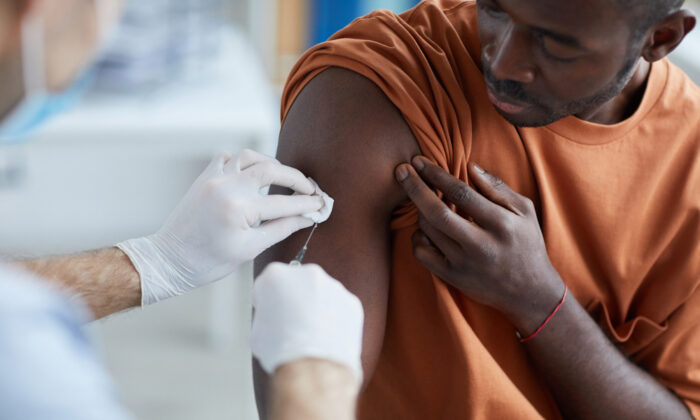
Over 270 athletes and former athletes in the United States have died from cardiac arrests or other serious issues after taking COVID-19 vaccines, according to data from a recent peer-reviewed letter to the editor.
Authored by structural biologist Panagis Polykretis, and board-certified internist and cardiologist Dr. Peter McCullough, the letter’s cited data found that from 2021 to 2022, at least 1,616 cardiac arrests or other major medical issues have been globally documented in vaccinated athletes, with 1,114 of those being fatal.
The global data also showed that between 2021 to 2022, former and current American athletes made up 279 of the mortalities.
The letter’s data comes from a compilation of news reports on medical emergencies in both professional and unprofessional vaccinated athletes. Vaccine statutes are deduced based on the affected person’s statements or vaccine mandates issued by their employers or schools.
Athletes have a lower chance of cardiac arrest and sudden cardiac death as compared to nonathletes. A 2016 U.S. study calculated that nonathletes, compared to athletes, have a 29 times higher chance of sudden cardiac death.
One of the reasons is because “athletes are screened out for the common causes of sudden death on the playing field,” McCullough told The Epoch Times.
Players are screened for hypertrophic cardiomyopathy, which makes up almost 50 percent of sudden cardiac deaths in athletes, as well as other less common heart abnormalities.
The intensive screening is what makes competitive-level sports safer than everyday sporting activities, McCullough argued.
Sudden Cardiac Deaths in Athletes Increased After Vaccination
McCullough pointed to a European study that tracked sudden cardiac deaths in professional European athletes over 38 years from 1966 to 2004. The study reported 1,101 sudden cardiac deaths over the interval, which Polykretis estimated would be around 29 deaths per year.
This recent paper from Dr. Polykretis and myself gets the sharp rise in athlete deaths into PUBMED. Since vaccination, “1598 athletes suffered cardiac arrest, 1101 of which with deadly outcome. Over a prior 38-years (1966-2004), 1101 athletes < age of 35 died (~29/yr). https://t.co/lGWFctLx2L pic.twitter.com/SCieZTsoNZ
— Peter A. McCullough, MD, MPH™ (@P_McCulloughMD) January 3, 2023
In the United States, it is estimated that 100 to 150 athletes die every year from sudden death.
The data cited in the letter, however, showed that in 2022 alone, over 190 deaths from cardiac arrests or other factors have been reported in current and former athletes.
This does not include the deaths of athletes with unknown vaccine statuses and those whose names did not make it into the media.
McCullough said looking at the data, “there’s no doubt,” that sudden cardiac deaths have increased following vaccinations.
However, since most of the sudden cardiac deaths in the media are of professional competitive players, McCullough added that collecting data from athletes in colleges, high schools, and other international leagues would give a more comprehensive picture.
He pointed to studies that have shown high myocarditis increases following COVID-19 vaccinations.
Prior to the pandemic, a 2017 study in Finland found that myocarditis rates were 19.5 per million for children 15 years of age and younger. Another 2012 Japanese study on pediatric admissions reported even lower rates of 2.6 cases per million in children aged 1 month to 17.
In the data released by the Centers for Disease Control (CDC) and Prevention in June 2021 (pdf), researchers expected myocarditis rates in vaccinated 12- to 17-year-old males to be 63 cases per million. By the following year, researchers at the CDC noted that myocarditis numbers in young males were exceeding the background rates (pdf).
A study by researchers from Kaiser Permanente (pdf), published in August 2022, estimated myocarditis would be 186 cases out of a million, after a second dose of vaccine in 12- to 17-year-old children. In males, this number was raised to 377 cases out of a million.
However, in prospective studies, one Thai study found that 2.3 percent of children who received two shots of mRNA doses had a heart injury. Another study evaluated 777 health care workers who were boosted and 2.8 percent reported a heart injury.
This means that if the results are extrapolated, around 25,000 people per million could suffer from heart injuries after two or three doses of COVID-19 vaccinations, according to McCullough.
“I’m very concerned,” said McCullough, “This is a public health problem. I think it is incumbent upon individuals to disclose the vaccine status.”
“We see the report of public figures or athletes one after another, dying suddenly, with no explanation. It’s incumbent upon the families, the medical staff, the doctors, and the reporters to disclose the vaccine status. They are investigational vaccines, and they are linked to death in peer-reviewed studies.”
A German autopsy study evaluated 25 people who died unexpectedly within 20 days of being vaccinated. Four of the individuals were found with myocarditis without any other disease signal that may have caused the unexpected death.
The authors concluded that their autopsy studies indicated that deaths were due to cardiac failure, and that myocarditis could be “a potentially lethal complication following mRNA-based anti-SARS-CoV-2 vaccination.”
It should also be noted that myocarditis events have also been reported in unvaccinated COVID-19 patients in 2020, and studies have shown that the virus can cause heart damage. But it is debatable if the heart injuries patients experience are caused by myocarditis or some other reasons.
A study published in April 2022 found that increases in myocarditis and pericarditis are statistically insignificant among unvaccinated individuals after COVID infection. The researchers evaluated around 197,000 unvaccinated patients, and there were 9 and 11 cases of myocarditis and pericarditis, respectively.
A French study that tracked cardiac arrests in athletes pre-pandemic from 2005 to 2018 also found that the rate of cardiac arrests in sports has remained constant, while survivability of these events has increased due to help from bystanders.
